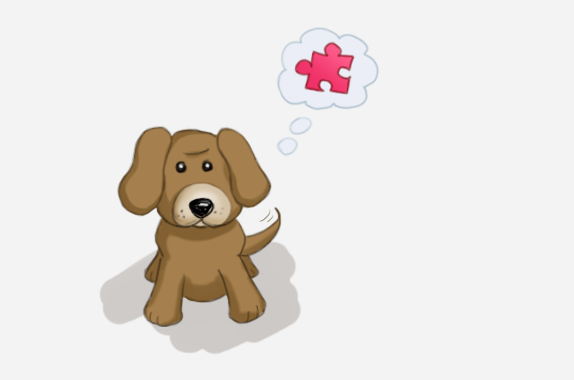A little over a year ago, vet student Marie Francesca Menniti shadowed our Head Vet Sean for two weeks to learn the ins and outs of tails.com; how we create a unique recipe for every dog with the nutrition they need in a taste they love. Fast forward to today, Marie has graduated from University and is working as a vet. She recently won the American Academy of Veterinary Nutrition (AAVN) Companion Animal Blog Competition. We think this deserves a celebration and so wanted to share her blog with our readers. Read on for her article (that will also appear in the AAVN newsletter):
Tetris for your Terrier, Sudoku for your Saluki: Puzzle Feeders
Just as Tetris, Sudoku, and the good old jigsaw are fun puzzle challenges for us, puzzle feeders are a great way to keep your pooch entertained. Puzzle feeders are toys which are manipulated by your dog to dispense individual tasty tidbits. These feeders are so captivating that they are frequently used as boredom busters to redirect unwelcomed behaviours in the home- I’m looking at you chronic barkers and “home redecorators”.
How to integrate puzzle feeders in your dog’s meal routine
Puzzle feeders can easily become part of your dog’s meal routine. Rather than using high-calorie treats, a portion of your dog’s daily kibbles can be used to load the puzzle feeder. We’ve all met Beagles who can make entire bowls of food disappear in the blink of an eye. Especially in their case, a puzzle feeder can be used to prolong meal time. Most of the time, your dog will be so excited at the prospect of a new game that they’ll hardly notice the difference! These toys prevent begging behavior in-between meals and are often recommended to pets on a calorie-limited diet.
Types of puzzle feeders
There are two main types of puzzle feeder: the bowl slow feeder and the interactive challenge feeder. Bowl slow feeders look like shallow mazes which are inset into your dog’s food bowl. The walls of the maze are just wide enough for your dog’s tongue to pass through and they have to skillfully maneuver to retrieve each morsel. When it comes to interactive challenge feeders, there are a lot of options available. Your dog may have to roll a ball along the floor, nudge a slider door with their nose, or operate a push button to get to their meal. Advanced level feeders will require dogs to fulfill two different actions before getting their reward, such as pulling out a pin to unlock a treat-holding drawer. When choosing a puzzle feeder, ensure that the challenge won’t be too difficult for your dog and that the rewards are able to fit through the puzzle windows. However, with so many options, it’s easy to find a feeder that works well for your dog and their diet. Many people have had success with creating their own interactive puzzle feeders. There are plenty of online resources that can be used for inspiration. One good place to start is the Snuffle Mat puzzle feeder project by Dogs Trust. You can find the link to make your own here. Try rotating two or three puzzle feeders every few weeks to ensure your dog always has a fresh challenge.
Whether purchasing from the local pet store or crafting your own at home, watching your dog work through a puzzle feeder challenge is a lot a fun. It’s no coincidence that searching for “dog puzzle feeder” online yields hundreds of video results! Although most dogs use the trial-and-error approach, it is satisfying to watch them master a new skill and gradually decrease the time taken to solve their puzzle. Keeping an eye on your dog means you can also ensure they aren’t getting too frustrated and give a little hint when needed.
Who are puzzle feeders for?
So, puzzle feeders seem great all around! You might be asking yourself, is there any reason that they shouldn’t be used? There certainly is a group of dogs that would not be well-suited to using interactive puzzle feeders, particularly surrounding mealtimes. Some elderly dogs may have difficulties with their sight and sense of smell, both of which are required to fully engage in an interactive puzzle feeder. Additionally, they may have difficulties chewing and fare much better on a wet diet than on hard, crunchy kibbles. These older dogs need a bit of extra tender loving care to ensure that they consume all the calories they need in a day. It’s best to leave the complicated puzzle feeders to the frisky youngsters! Certain illnesses are also incompatible with advanced puzzle feeding. For example, there is a condition called “megaoesophagus” in which food has trouble passing to the stomach after being swallowed. Dogs with megaoesophagus must be fed from a stationary elevated position- no intricate button-pressing or ball-rolling allowed! Always keep in mind your dog’s own special needs before settling on a puzzle feeder and stay attentive for signs that a particular puzzle feeder isn’t a good fit for them.
Puzzle feeders are so much more than simple novelty toys. They’re a fun way to bond with your dog and keep busy minds out of trouble. Furthermore, they help to manage fast-eating fiends and will fit into the mealtime ritual for most of our four-legged friends. Tetris? Sudoku? Jigsaw? I’d like to see one of those puzzles be able to do all that!

